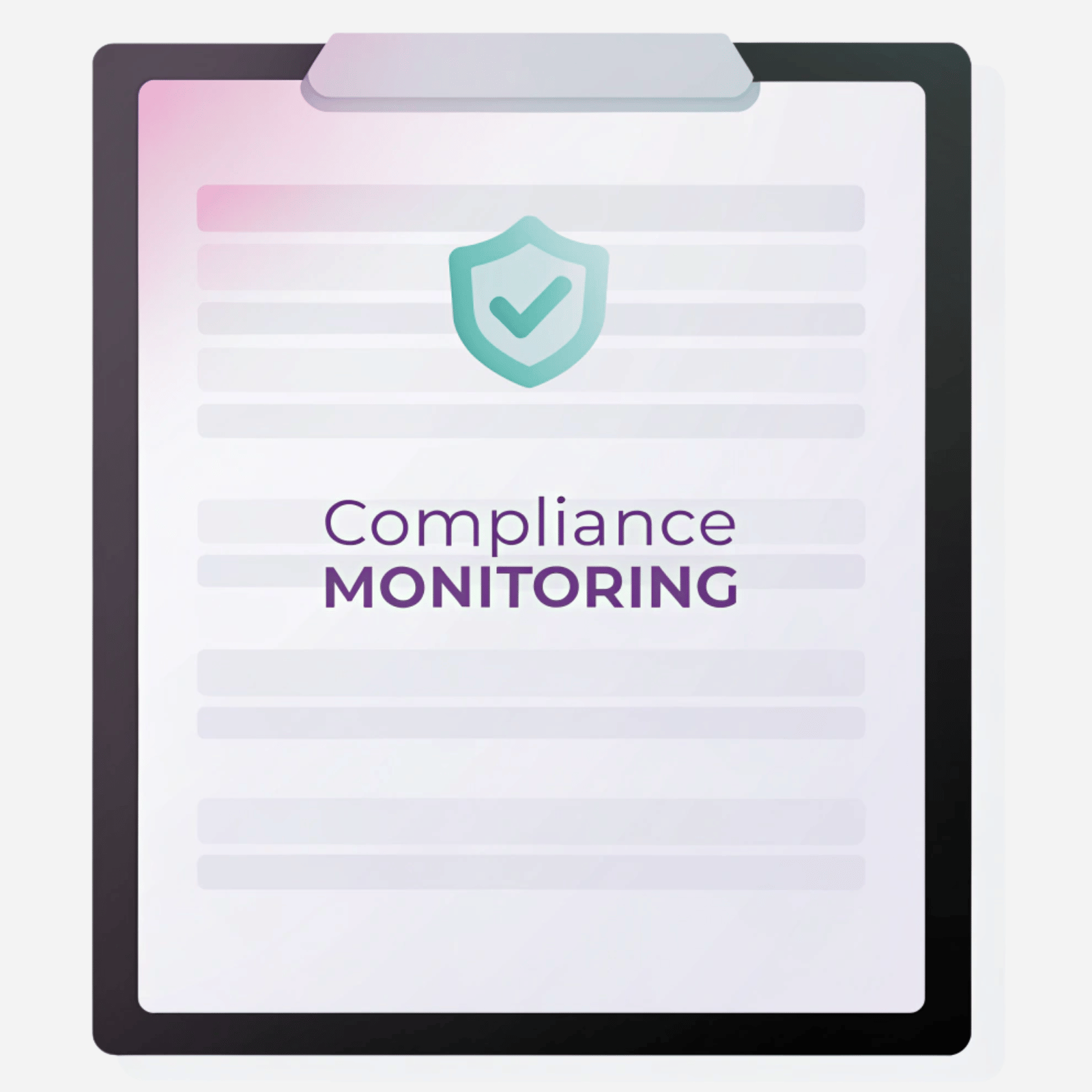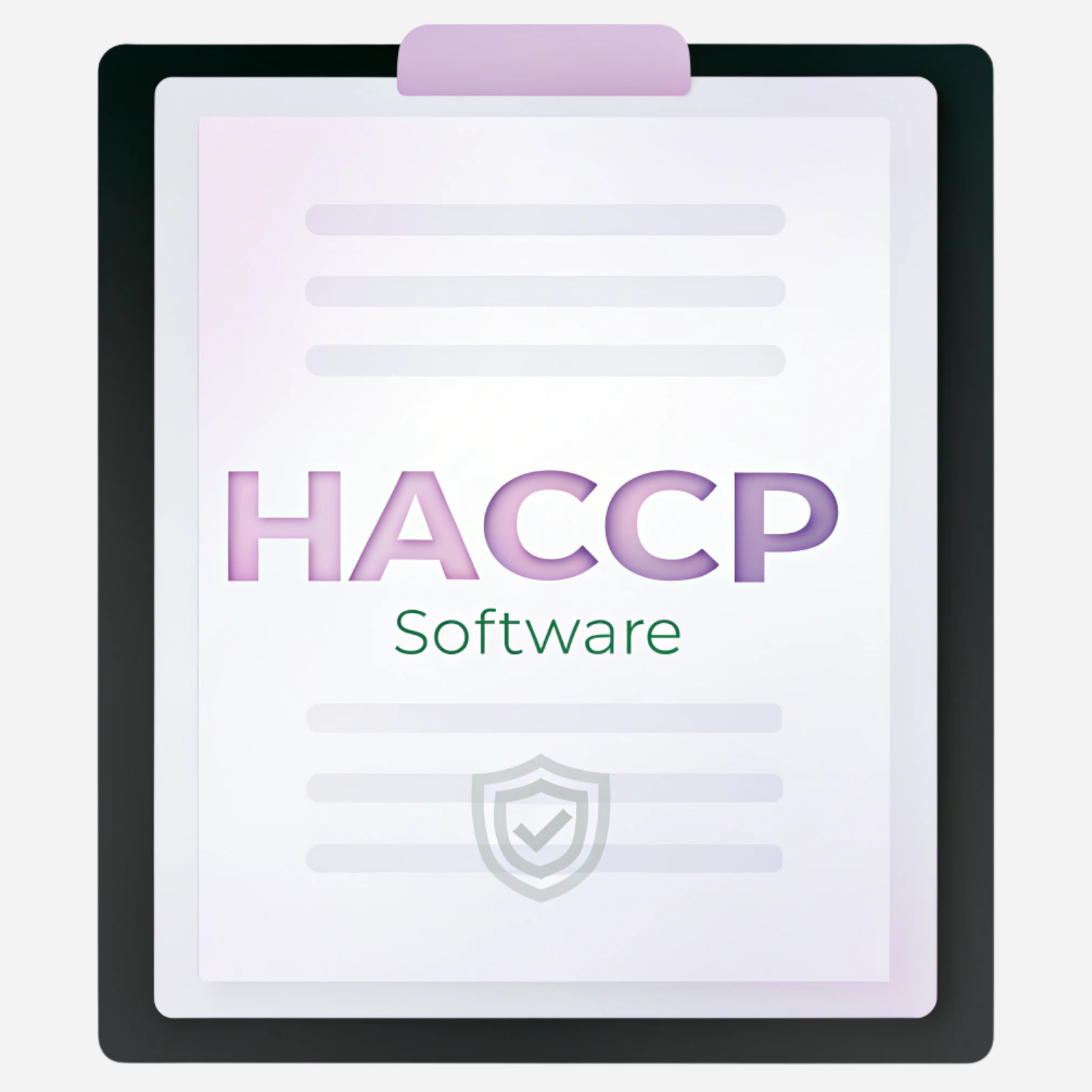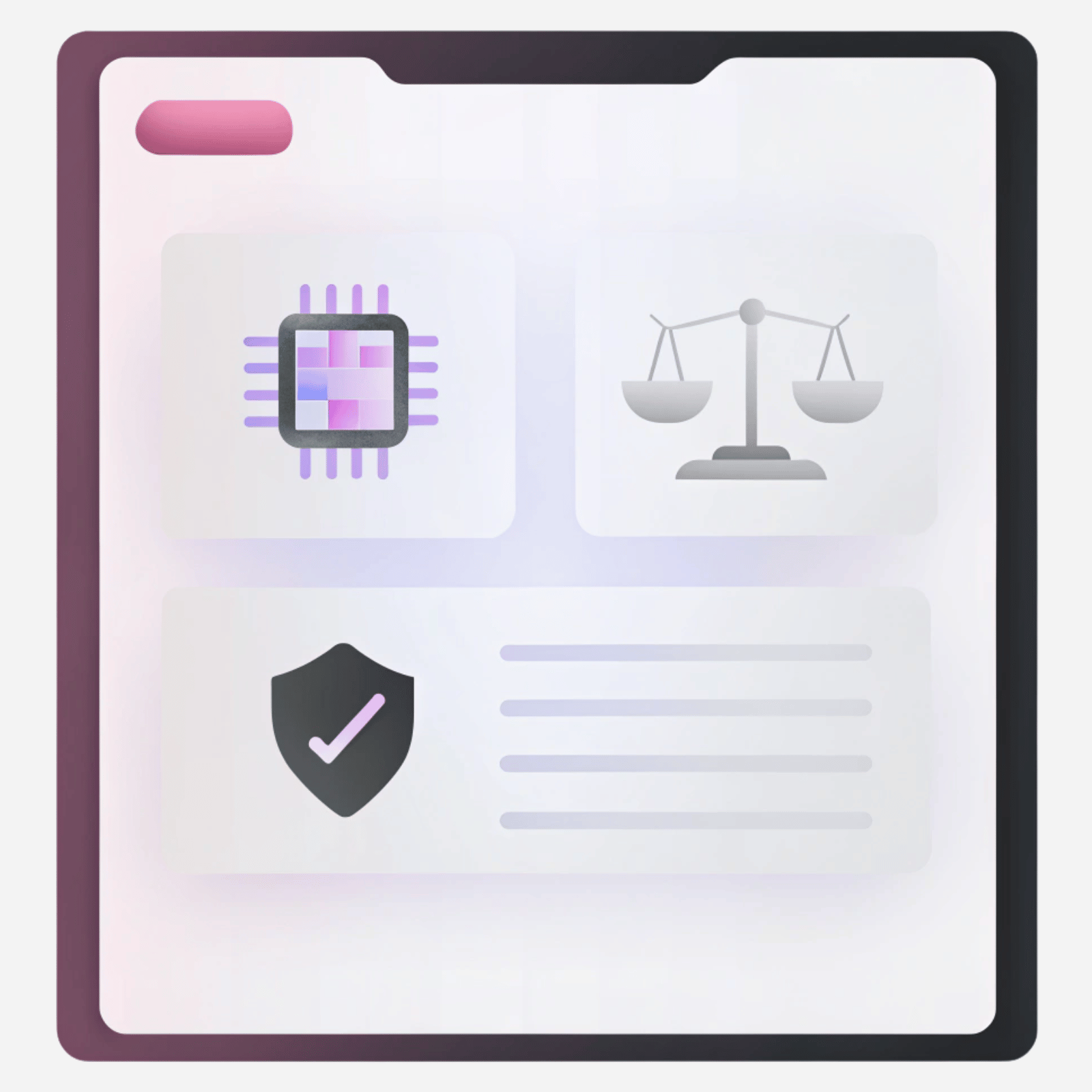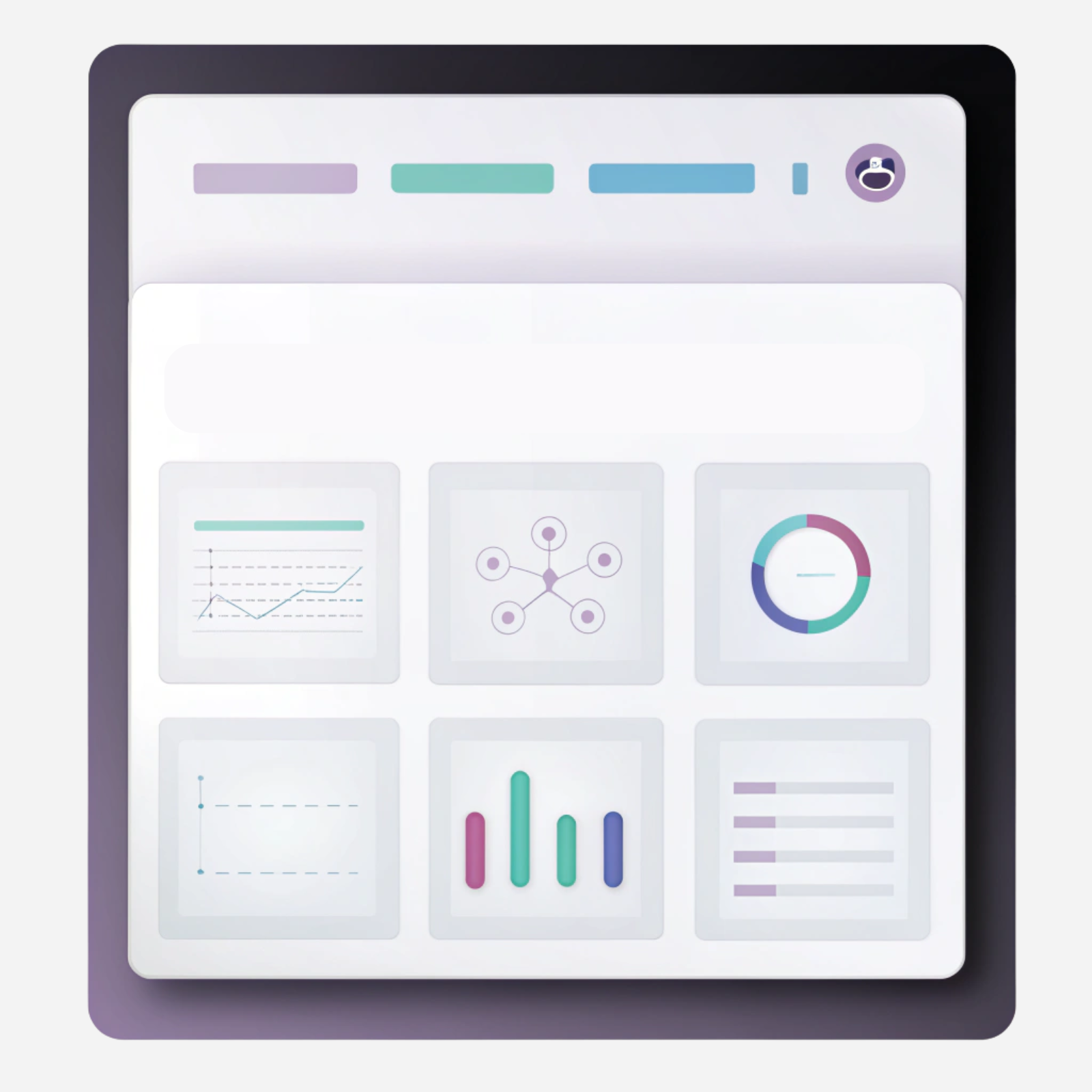
What is Automated Regulatory Intelligence (ARI)?
How many regulatory updates can your compliance team realistically track in a week?
With thousands of new rules, amendments, and guidance documents issued globally every year, most companies can’t keep pace using traditional manual methods.
This challenge is driving the adoption of Automated Regulatory Intelligence (ARI) technology, which transforms how businesses monitor, analyze, and respond to regulatory changes.
ARI uses AI and machine learning to automate the gathering and interpretation of regulatory data. As part of broader Regulatory Intelligence Automation, ARI replaces time-consuming manual monitoring with real-time, accurate insights.
Why Manual Regulatory Monitoring No Longer Works?
Manual processes like spreadsheets, bookmarks, and email alerts were once sufficient. Today, they are unprofitable for several reasons:
- Information Overload: Regulatory bodies generate thousands of updates per year in sectors like financial services, healthcare, and life sciences. Missing even one key update can expose a company to compliance failures.
- Time and labor-intensive: Compliance teams spend hours reviewing newsletters, websites, and PDFs. A 2023 report found that companies waste an estimated $760–$935 billion annually in compliance inefficiencies in the U.S. in healthcare alone.
- Error-Prone Tracking: Manual systems are prone to mistakes, inconsistent tracking, and a lack of auditability. AI-driven systems improve data accuracy by up to 87% and reduce response times by 76%, according to recent studies in healthcare compliance.
- Rising Regulatory Complexity: Global compliance spending now exceeds $270 billion per year, much of it tied to managing complex, fragmented regulatory landscapes without automation.
ARI: The Smarter, Automated Alternative
- Automated Data Gathering: AI tools scan thousands of regulatory sources in real time, eliminating the need for manual data collection.
- Advanced Processing & Insight Extraction: Machine learning automatically classifies and extracts relevant regulatory changes, slashing the time spent on document review.
- Context-Aware Prioritization: ARI systems map updates directly to business policies, controls, or risk levels so teams know what truly matters - fast.
By shifting from “collect-then-analyze” manual workflows to AI-powered Regulatory Intelligence Automation, ARI empowers compliance professionals to transition from reactive firefighting to strategic risk management and decision-making on a far more accurate, efficient, and scalable basis.
How AI Powers Regulatory Intelligence Automation
After understanding why traditional compliance tracking struggles to keep pace, the question arises: how exactly does AI improve the process?
At its core, Automated Regulatory Intelligence uses artificial intelligence to automate and enhance what was once a manual, resource-heavy process. Rather than relying on teams to search, interpret, and distribute regulatory updates, Regulatory Intelligence Automation allows AI systems to handle much of this workload, reducing errors and speeding up responses.
Here’s a clear breakdown of how AI powers Regulatory Intelligence Automation in practice.
1. Automated Data Collection (Web Crawling and API Feeds)
AI algorithms constantly monitor thousands of regulatory sources:
- Official websites
- Legal databases (like Lex, GDPR, etc.)
- Industry bodies
- News outlets
Using automated crawlers and APIs, AI systems collect updates far faster and more comprehensively than manual teams could.
Example: An AI-based ARI tool might scan 1,500+ regulatory sources daily across 50+ jurisdictions.
2. Natural Language Processing for Document Understanding
Regulatory texts aren’t standardized. Using NLP, AI reads and understands:
- Laws or other high-level regulations
- Guidelines (Internal policies, ISOs, SOPs, etc.)
- Amendments
- Notifications
NLP enables ARI systems to:
- Extract key details (effective dates, affected sectors, jurisdictions).
- Identify regulatory type (mandatory regulation, voluntary guidance, industry best practice).
- Summarize complex legal language into actionable summaries for compliance professionals.
3. AI-Powered Relevance Filtering
Not every update applies to every company. AI models assess:
- The industry’s specific
- Operational geographies (localization)
- Product lines and services
- Manually provided specifications
Using this, ARI filters and prioritizes only relevant regulatory updates for your business. This replaces manual triage, preventing alert fatigue.
Result: Instead of 200 generic updates, a compliance team might see only 15–20 updates requiring their attention.
4. Risk Mapping and Impact Assessment
Advanced ARI tools map regulatory changes to:
- Existing internal policies
- Control frameworks (e.g., ISO standards, GxP in pharma, GDPR)
- Known risk categories
This allows AI to flag:
- Which regulations directly affect which internal policies and how.
- Potential operational risks or non-compliance exposures.
- Raise the latest changes that have not been implemented yet.
5. Automated Reporting and Audit Trails
AI systems can:
- Generate compliance reports automatically.
- Log all regulatory updates received and actions taken.
- Create exportable records to support audits and inspections.
This ensures transparency and traceability, without relying on manual documentation.
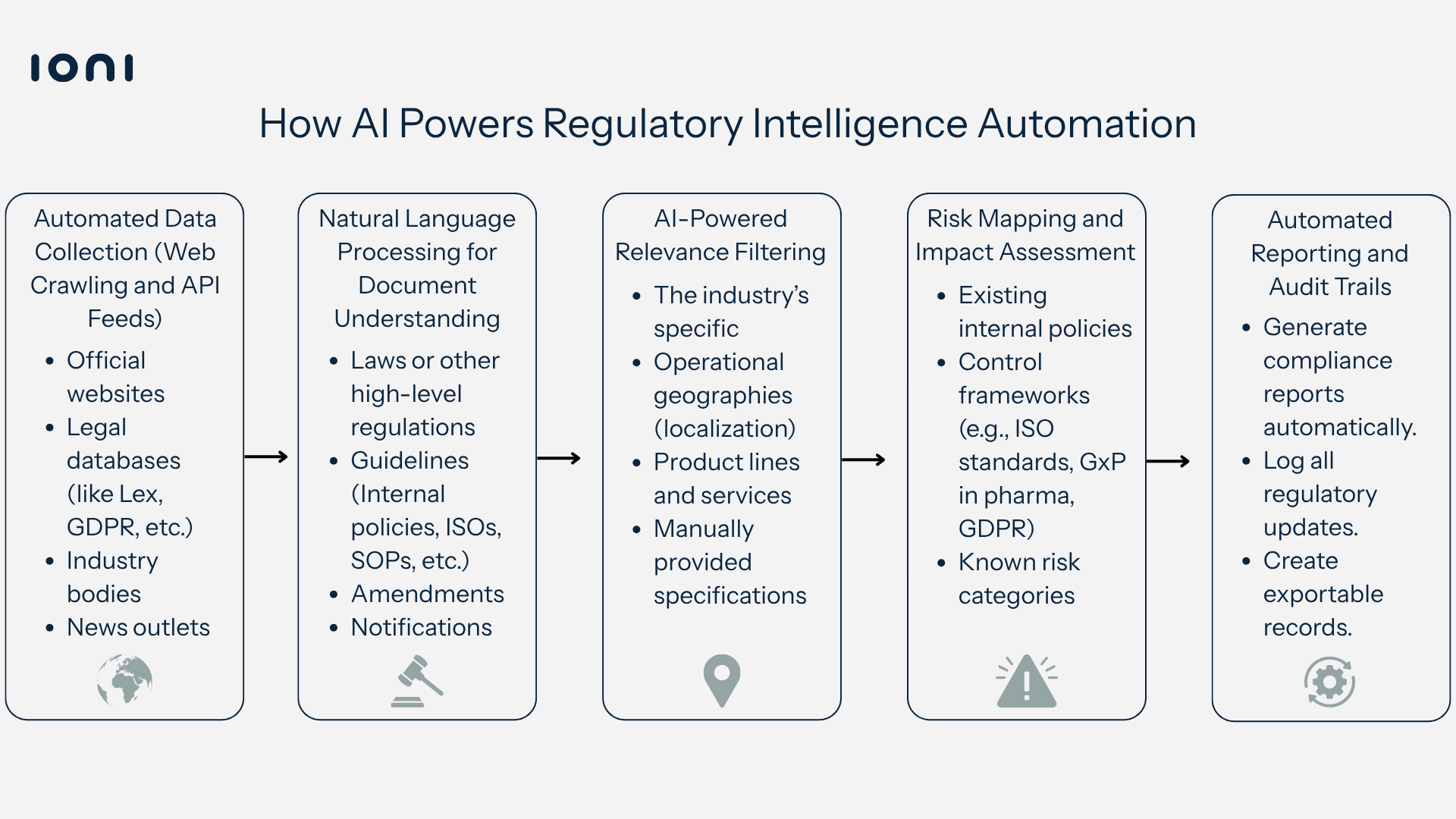
Why This Matters
By integrating AI at each stage, Regulatory Intelligence Automation shifts from basic monitoring to:
- Constant real-time awareness
- Business-specific relevance filtering
- Faster decision-making
- Stronger compliance documentation
In other words, AI helps companies track regulations and understand and act on them intelligently.
The Benefits of Automated Regulatory Intelligence for Compliance Teams
Compliance professionals are finding that Automated Regulatory Intelligence is essential for modern compliance functions. Here’s why Regulatory Intelligence Automation significantly boosts performance, accountability, and strategic insight:
1. Enhanced Efficiency & Cost Savings
ARI can reduce manual compliance efforts by 30–40%, allowing teams to reallocate resources toward strategic tasks rather than routine monitoring.
The RegTech market is expected to grow from US$18.9 B in 2025 to $33.8 B by 2029, driven largely by the efficiency gains from automation
2. Real-Time Accuracy & Risk Reduction
ARI systems equipped with NLP and machine learning can improve data handling accuracy by up to 87% while speeding response times by 76% compared to manual methods.
Automated systems ensure that no critical update slips through the cracks, helping teams maintain consistent compliance and reduce risk.
3. Targeted Prioritization & Cognitive Support
Predictive analytics built into ARI reveal emerging regulatory trends, such as upcoming changes to data privacy or AI legislation, enabling proactive preparation.
By filtering information based on jurisdiction, sector, and internal risk profiles, ARI ensures teams see only what matters, cutting alert volume from hundreds to just a handful each week.
4. Stronger Collaboration & Reporting
One study found that 48% of compliance officers cite workload management as a key challenge, and 74% of compliance failures stem from human error.
ARI’s automated tracking, impact mapping, and audit trail creation enhance transparency and cross-team communication, critical during audits or regulatory inquiries.
5. Strategic, Future-Ready Compliance
ARI shifts compliance from reactive to strategic, allowing teams to anticipate regulatory shifts and shape policies accordingly.
The emergence of “Compliance 3.0” signals a new era of data-driven, AI-augmented regulation, putting businesses ahead of the curve.
By implementing Automated Regulatory Intelligence, compliance teams can reduce costs, improve accuracy, and move from repetitive tasks to risk management and policy shaping.
Real-World Use Cases of ARI in Action
Building on the clear benefits of ARI, it’s worth asking: how are real companies actually using these tools?
From food safety to biotech, businesses across sectors are harnessing Automated Regulatory Intelligence, which is central to Regulatory Intelligence Automation, to improve compliance, drive efficiency, and reduce risk.
Food Safety: AI‑Generated HACCP Planning & Real‑Time Alerts
Consider the food industry: managing HACCP (Hazard Analysis Critical Control Point) plans across multiple facilities is complex and time-consuming. With AI, ARI tools can:
- Automatically draft HACCP plans tailored to specific operations and ingredients.
- Continuously scan regulatory databases for changes in standards.
- Generate instant audit‑ready reports and traceability logs for inspections.
IONI offers features like real‑time monitoring, policy enforcement, and HACCP planning via AI agents, helping food producers maintain compliance with evolving standards.
Pharma & Biotech: Signal Detection, Labeling & Submission Planning
In pharmaceuticals and biotech, delays or errors in regulatory processes can have high stakes. Here’s how ARI is being used:
- Global monitoring of updates from agencies like the FDA, EMA, and PMDA - detecting changes in approval timelines, manufacturing rules, or clinical guidelines.
- Adverse event signal detection: AI tools identify safety patterns from real-world evidence weeks ahead of manual review.
- Labeling consistency checks: AI compares label versions (e.g., FDA vs. EMA) to spot discrepancies in contraindications or dosage info.
- Submission optimization: AI-powered tools prepare dossiers and predict regulatory questions, reducing risks in filings.
These applications help pharma and biotech firms stay agile and audit-ready by automating complex regulatory workflows.
Financial Services: Real-Time Monitoring of Regulatory Changes & Anti-Financial Crime Compliance
In banking and finance, regulatory landscapes change almost daily, driven by anti-money laundering (AML) laws, sanctions updates, and financial reporting standards. Manual monitoring is impractical, especially for global firms operating across multiple jurisdictions. ARI tools help by:
- Monitoring global financial regulations in real-time - tracking changes from bodies like the SEC, EBA, and FCA.
- Sanctions screening: AI systems integrate real-time sanctions list monitoring, updating watchlists automatically.
- Anti-money laundering compliance: By processing transaction data alongside evolving AML rules, AI tools help detect suspicious patterns earlier.
- Regulatory reporting: ARI solutions generate and update compliance reports for MiFID II, Basel III, or Dodd-Frank with minimal human input.
For example, financial institutions using AI-driven Regulatory Intelligence Automation tools can reduce compliance workload by 30–40% while ensuring consistent adherence to fast-changing regulatory requirements.
IONI in Compliance
IONI supports gap analysis, policy enforcement, and real-time regulatory intelligence tailored to any high-regulation sector.
In food safety, IONI’s HACCP AI agent automates plan drafting and compliance checks .
For broader compliance teams, IONI offers tools like document summarization, regulatory monitoring, and audit traceability , showcasing its role in Regulatory Intelligence Automation.
Why These Use Cases Matter:
- Speed: Safety signals were flagged two weeks earlier than before
- Accuracy: Consistency checks across multiple labels and regions
- Efficiency: AI drafts HACCP and dossiers in minutes instead of days
- Compliance: 24/7 monitoring and real-time reporting reduce human oversight
Watch how IONI works
Choosing the Right ARI Solution: What to Look For
After seeing real-world examples across industries, the next question is: How do you choose the right ARI tool for your business? Here's what to look for when selecting an Automated Regulatory Intelligence solution:
If Regulatory Intelligence Automation is the future of compliance, choosing the right platform determines whether you stay ahead or lag.
1. Coverage & Signal Quality
Look for solutions that scan a broad range of sources - regulatory agencies, standards bodies, news, global jurisdictions—with automatic aggregation and deduplication. The best platforms combine AI-powered signal extraction with meaningful context.
2. AI-Powered Mapping & Prioritization
Beyond gathering data, the tool should use ML to link updates directly to your internal policies, risk frameworks, or product lines. This reduces noise and directs attention to high-impact alerts.
3. Efficiency Gains & ROI
A quality ARI platform should deliver 20–50× efficiencies in mapping, analysis, reporting, and review. Ask vendors for ROI models based on real use cases and data volumes.
4. Governance & AI Trustworthiness
Verify features like explainability, confidence scoring, human-in-the-loop review, and audit trails. Secure certifications such as SOC 2 or ISO 27001 ensure data integrity and compliance with privacy standards.
5. Integration & Workflow Flexibility
Effective ARI solutions offer robust APIs and configurable workflows, making it easy to embed into existing GRC systems or document repositories.
6. Vendor Credibility & Case Studies
Look for providers listed on RegTech 100 or recognized by industry analysts. Seek case studies - especially in your sector - that demonstrate tangible results.
Spotlight: IONI – A Top ARI Candidate
Our notable solution, IONI, stands out as a strong ARI solution due to these features:
- Wide content ingestion: Captures global sources and translates insights into interactive regulatory maps.
- Smart summarization: AI agents draft policy documents and compliance plans, such as HACCP in food safety, while mapping impact.
- Efficient ROI: Offers predictive efficiencies within the 20–50× range expected by compliance teams.
- Governance built-in: Supports audit trails, confidence scores, and secure, compliant deployment models.
These strengths make IONI a strong contender for teams ready to adopt full-scale Regulatory Intelligence Automation.
Quick Checklist: Choosing Your ARI Platform
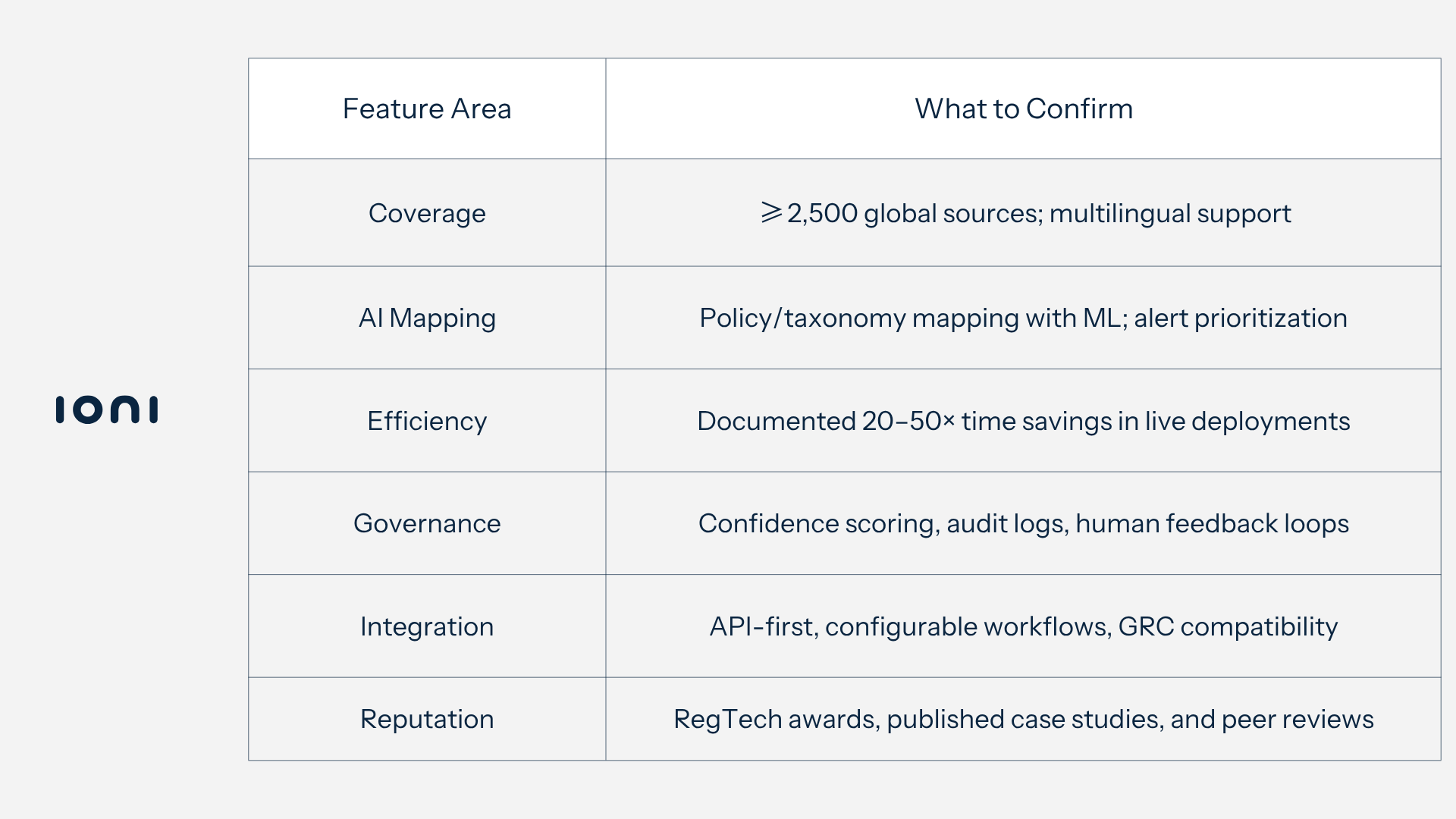
How to Integrate ARI Into Your Compliance Workflow
Having selected a robust ARI platform like IONI or another, the next step is integrating Automated Regulatory Intelligence into your team’s daily routines. Here’s a detailed, step-by-step guide to implementing Regulatory Intelligence Automation into your compliance workflow:
1. Define Clear Objectives and Scope
Before implementation, clarify your goals:
- Which regulatory domains (e.g., food safety, GDPR, AML) will ARI cover?
- Which internal teams (legal, quality, operations) will use it?
- What outcomes are expected (e.g., 30% time savings, zero missed updates)?
- Document scope, responsibilities, and key performance indicators (KPIs).
2. Map Current Processes and Identify Gaps
- Audit existing monitoring processes: information sources, workflows, and reporting tools.
- Identify pain points: manual research, delayed alerts, or low auditability.
- Map out where ARI can plug into current steps - e.g., replacing manual source review, feeding alerts to policy teams, or automating impact logs.
3. Configure Source Coverage and Relevance Profiles
- Set up the ARI system to monitor relevant sources: regulatory databases, agency sites, standards bodies, and industry news.
- Define priority areas - by jurisdiction, topic, or department.
- Train the system with sample regulatory documents and internal policy references to help AI learn your organization’s specific context.
4. Build Review & Triage Workflows
- Create dashboard-based triage queues for compliance analysts, with rules to assign alerts by region, product area, or urgency.
- Configure automated alerts - via email, Slack - tagged with metadata like “Food Safety: High Priority”.
- Set review cycles (daily/weekly) and feedback loops where analysts confirm or dismiss alerts - this reinforces learning.
5. Implement Policy Alignment & Impact Analysis
- Upload internal policies, control frameworks, or SOPs into the ARI tool.
- Ensure the system can auto-map incoming updates to these documents and highlight affected clauses or procedures.
- Analysts review hyperlink-enabled impact reports and annotate where changes are needed.
6. Automate Documentation & Reporting
- Enable ARI’s auto-generated reports, capturing key metadata: date, jurisdiction, summary, impact, and action taken.
- Integrate with document systems or GRC platforms to log changes, assign tasks, and create incident records.
- Use reporting features to export audit-ready dashboards or logs, minimizing manual paperwork.
7. Integrate With Existing Tools
- Connect ARI via APIs to risk, governance, or quality management systems (e.g., GRC solutions).
- Link alerts with task-management tools like Jira, Asana.
- Ensure smooth syncing of updates, policies, and audit records across systems.
8. Establish Feedback Loops & AI Refinement
- Schedule regular calibration meetings (monthly or quarterly) to review false positives or missed alerts.
- Use the ARI tool’s feedback features to retrain ML models.
- Track AI performance metrics - like accuracy, volume of alerts, or processing time - to meet ROI targets.
9. Train Users and Clarify Roles
- Conduct training sessions covering: dashboard use, alert triage, impact assessment, and report generation.
- Define roles - e.g., “Policy Reviewer,” “Compliance Analyst,” “GRC Owner” - and assign responsibilities.
- Maintain user guides and update them as workflows evolve.
10. Monitor, Evaluate, and Continuously Improve
- Use defined KPIs (e.g., time saved, compliance accuracy, number of missed alerts) to evaluate ARI performance quarterly.
- Adapt coverage to new domains (e.g., ESG, cybersecurity) over time.
- Share results with senior management - highlighting time savings, risk reduction, and audit readiness.
By following these steps, your business can successfully embed Automated Regulatory Intelligence into existing processes, creating a Regulatory Intelligence Automation system that’s consistent and audit-ready.
What the Future Holds for ARI and Compliance AI
With ARI now integrated into daily workflows, it’s natural to ask: where is this technology heading next?
Automated Regulatory Intelligence is evolving into a strategic engine for regulatory risk management.
As Regulatory Intelligence Automation matures, several trends will redefine how compliance teams operate in the coming years.
1. Predictive Compliance Systems
Instead of simply responding to changes, future ARI systems will use predictive analytics to forecast regulatory shifts. By analyzing historical patterns and legislative cycles, AI can help businesses anticipate upcoming regulations and prepare in advance, especially in fast-changing areas like AI governance, ESG reporting, and digital privacy.
2. Industry-Specific AI Agents
Generic compliance tools will give way to domain-specific AI agents. In sectors like food safety, pharma, biotech, and finance, ARI systems will be pre-trained on industry-specific taxonomies, standards, and workflows, delivering out-of-the-box relevance without lengthy customizations.
3. Integration with Broader Risk Management
Future ARI platforms will merge more deeply with enterprise risk management (ERM) and governance frameworks. This will allow businesses to correlate regulatory changes with broader operational and reputational risks, helping compliance teams contribute to strategic decision-making.
4. Generative AI for Compliance Documentation
As large language models mature, ARI tools will increasingly use generative AI to:
- Draft policy updates,
- Create regulatory submissions,
- Prepare audit reports,
- Explain complex regulations in simple, actionable terms.
This shift will reduce manual documentation even further, allowing compliance professionals to focus on high-level risk assessment.
5. Real-Time Cross-Jurisdictional Harmonization
With global regulations increasingly fragmented, next-generation ARI solutions will support real-time comparison and harmonization across jurisdictions. AI will help map conflicting standards and recommend region-specific adjustments, crucial for global companies managing compliance in multiple markets.
6. Ethical and Transparent AI Governance
As AI becomes embedded in compliance, regulators themselves will likely introduce governance requirements for ARI systems. Expect future solutions to:
- Include explainability features,
- Offer human oversight modes,
- Provide full audit trails of AI-generated recommendations.
Regulatory Intelligence Automation will need to comply with emerging AI regulations - a meta-layer of compliance.
In Summary
The future of Automated Regulatory Intelligence points toward systems that:
- Predict change,
- Automate responses,
- Reduce manual work,
- Enable strategic foresight,
- And comply with AI governance standards themselves.
In this landscape, platforms like IONI - and others investing in AI innovation - are well-positioned to help compliance teams move to proactive, data-driven leadership.
FAQ
What industries benefit most from Automated Regulatory Intelligence?
While ARI is widely used in finance, pharma, and biotech, it's increasingly adopted in food safety, energy, telecommunications, and cybersecurity - any sector facing complex, evolving regulations.
Does ARI replace compliance officers?
No. ARI augments compliance teams by automating routine tasks like monitoring and reporting, allowing human experts to focus on analysis, decision-making, and strategic planning.
How often do ARI tools update regulatory data?
Most leading ARI systems operate in near real-time, scanning sources 24/7 and pushing updates as they’re published by regulators.
What’s the average implementation time for an ARI solution?
Depending on organizational size and complexity, ARI solutions can typically be configured and operational within 4 to 12 weeks, including training and integrations.


